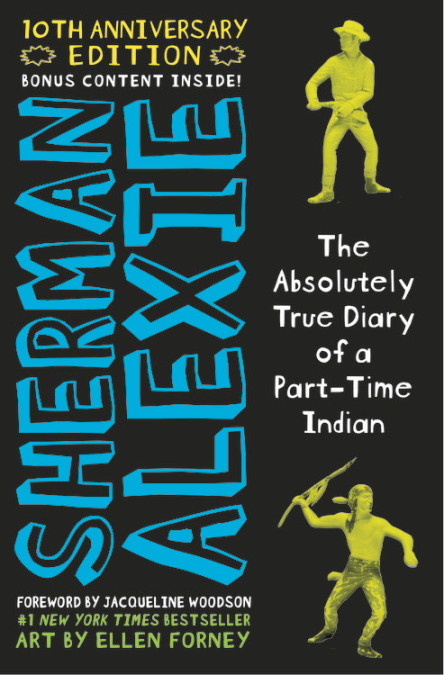by Julia López-Robertson, Deanna Futrell, Jennifer Judy and EDRD 797, The University of South Carolina

The Absolutely True Diary of a Part-Time Indian (2007) light-heartedly opens our eyes to an ongoing cycle of constant struggle and deep injustices that are present in the American Indian community. Sherman Alexie uses humor to address the stereotypes and biases that many people have toward American Indians. In our group discussion we focused on the notions of racism, stereotypes and biases toward other cultures in the classroom and how to deal with these sensitive topics with our multicultural students. Becca made a comment that appropriately confronts the issue at hand: “We need to put our students face-to-face with these issues so that they can see these cultural groups as people just like us, who want the same things we do: access to jobs, education, housing, plenty of food, and security for your family.”
Raising awareness, deconstructing racial barriers, examining misconceptions, building relationships and celebrating differences were some of the most prevalent solutions in our discussion on racial tensions in the classroom. In response to Bruce’s (2003) stance on raising awareness of racial misconceptions to reduce prejudices, Amber says, “If we make sure our students are aware of the stereotypes about all different individuals, they will become more knowledgeable and sensitive when they are put in these situations. I think these conversations will only make the group stronger and more aware of what is going on around them.” All of the group members agreed that making an effort to bring all aspects of a particular culture to the surface will make our students more comfortable in the classroom.
As teachers, one of our main goals should be to encourage our students to be critical thinkers and to develop the ability to approach sensitive issues with an open mind. Kirsten suggested how to initiate discussion on sensitive topics by sharing, “teachers can take an academic stance on some of the issues at first, and then allow discussion and opinion to weed its way into the conversation.” After students get a grasp of the cultural background of a particular group they are less likely to acknowledge stereotypes and biases in other settings.
Bruce (2003) tells us that literature circles “bring diverse responses to a text and enable wider stances to be taken. This enriches readers’ comprehension and enhances critical understanding and application of information” (p.55). While we all agree that teachers and students should be involved in discussion about discrimination, Julie thinks introducing this topic is often “controversial and uncomfortable.”
The experiences Lisa shared, like bringing people from the community into the classroom to talk about their culture, helped her students “to ‘get’ the idea that [their] life knowledge is something they can only read about in books.” Bringing the funds of knowledge that our students and community members have to offer into focus is crucial in trying to understand cultural differences both inside and out of the classroom. In order to deconstruct these racial barriers we have to be able to approach these sensitive topics in an environment that is conducive to learning. In this environment students should feel comfortable and encouraged to be pride of their culture.
We also thought that the literature circles mentioned in the article Hoop Dancing (Bruce, 2003) were an excellent idea, because they “can be a great form of instruction and assessment if the teacher is an avid kid-watcher” (Amanda), “reflect the rich culture and funds of knowledge of Native Americans” (Saad) and “encourage students to be self-reflective and honest about their home culture” (Julie). Saad mentioned Inquiry projects based on Native American culture as another type of assessment. In addition, all activities need to be “culturally relevant and familiar to students,” because it promotes higher-level thinking (Bloom’s Taxonomy) that proves more valuable and memorable, according to Amanda. Moreover, Julie suggested a writing assignment or small group activity that causes students to consider his or her own experiences with discrimination. These ideas affirm that teachers can be advocates for their English language learners and promote equality for all.
Editor’s Note: The Absolutely True Diary of a Part-Time Indian by Sherman Alexie was reviewed by WOW Review, vol. 1
References
Alexie, S. (2007). The Absolutely True Diary of a Part-Time Indian. New York, NY: Little, Brown and Company.
Bruce, H. E. (2003). Hoop Dancing: Literature Circles and Native American Storytelling. English Journal, 93(1), pp. 54-59.
Marlowe, L. (October 29, 2011). Mass Confiscation of Native American Children Hasn’t Gone Away. The Irish Times, p. 12.
Please visit wowlit.org to browse or search our growing database of books, to read one of our two on-line journals, or to learn more about our mission.
